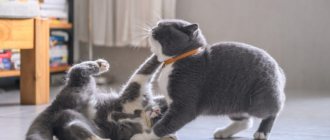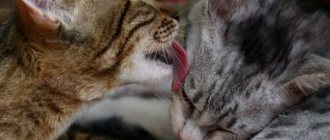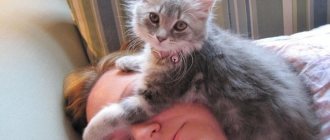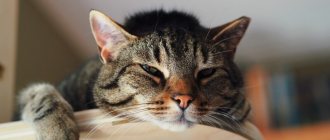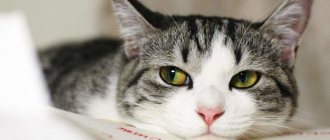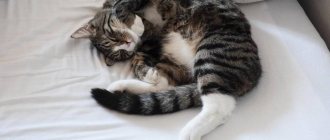In the process of long-term cohabitation between a cat and a person, both of them have no choice but to learn to understand each other: the pet’s speech, and the owner’s habits. Watching the animal, the owner after a while already sees its preferences and what irritates it. But the tailed one also watches people, hears human speech, adapts, learning to react correctly to it. Cat lovers, having spent many years with their pet (or more often than not, several), all as one, declare that cats understand perfectly well what is being said to them.
The more time the owner spends with the cat, the better she understands him, including all the methods of communication available to her - sounds, behavior, hearing, smells and even telepathy.
A little science
If a dog was consciously tamed by a person, then the same cannot be said about cats. Rather, the cat itself made contact with people who had food supplies. This happened about 10 thousand years ago, and since then little has changed in the balance of power between man and cat.
According to scientists, the reason lies in the cat’s naturally low communication needs. A cat does not particularly need the company of its own kind, much less representatives of another species, i.e. person. This is explained by the extreme caution of the animal. Biologist John Bradshaw, who studies the language system of felines, notes that compared to dogs, cats, even completely domestic ones, remain more wild and independent to this day.
Cat interests
In the course of studies conducted in a number of countries regarding cats, it was revealed that cats have more than 60 different sounds in stock, which they use to communicate with their relatives and the owner.
The most powerful indicator of domestic cats is their tail. It is much more mobile than that of dogs and is a kind of balancer. Moreover, a cat's tail is an indicator of their mood. By the waving of the tail, you can understand what mood the cat is in at a certain moment. For example, if a cat's tail is sharply raised up, this means joy from meeting its owner or an extreme degree of interest in what is happening.
Find out more Why does a cat need a tail>>>
The interests of the animal are quite simple:
- availability of delicious food;
- being near the beloved owner;
- peace of mind in the house where the animal lives;
- the absence of obvious enemies and encroachers on territorial borders.
The cat will be able to inform about its condition through its voice, the position of its tail or ears, as well as a number of other movements.
experimental part
Trying to find the answer to the question of whether cats understand human speech, scientists have spent a lot of effort.
Animal psychologists from the University. Loranda Eotvos (Budapest, Hungary) conducted an experiment in which people told 41 cats where food was hidden. In 70% of cases, cats identified the hiding place by a non-verbal clue - the movement of a person’s eyes towards the food. But the pets ignored the voice prompts.
The journal Animal Cognition describes a similar experiment conducted by American scientists. The cats had to overcome an obstacle course, while the owners intonation frightened or approved of their actions. It turned out that the cats acted by listening to the owner's speech.
A number of scientists from different countries conducted experiments that proved that the cat reacts to the owner’s calls, even if they are spoken in a foreign language.
The results of another experiment, published in the American popular science magazine Scientific American, prove that cats distinguish the owner’s voice from other voices, but are not in a hurry to react, first carefully assessing the situation.
All this confirms the correctness of the English naturalist, the famous writer Gerald Durrell, who argued that, like other animals, cats perceive the energy of a word, the wavelength and frequency of its sound.
Feedback from cat owners
My cats are fans of hiding. They choose not only boxes, but also all small spaces. We hold the shelves in our closets in special esteem - in the morning I often find someone’s fluffy tails or ears sticking out of a stack of clothes. I think this is due to the instinct of self-preservation - in nature, cats rarely sleep just on the road, but look for some secluded places. Pitchezz https://mainecoon-forum.ru/archive/index.php/t-20953.html
I have always dreamed of a snow-white cat. I started it, but she turned out to be deaf in both ears. My observations: 1) deaf cats scream very loudly; 2) they have a manic passion for cleanliness, for example, it takes 1.5 hours to bury the tray with a terrible roar; 3) a deaf cat hides all the time or climbs up, trying to lie with her back to the wall - it’s clear that she doesn’t hear footsteps and is afraid that someone will sneak up on her unnoticed. And deaf cats not only love their owners, they are dependent on us, which they value very much. Katarina1619 https://pikabu.ru/story/glukhaya_koshka_i_kak_ee_vospityivat_5297034
There are features that are common to all representatives of the cat world. And you need to know these features of the behavior and attitude of pets, then you can try to understand your cat and become true friends.
Speech to a cat
When trying to find out whether cats understand human speech, it is necessary to clearly define what constitutes speech. Philologists have long proven that speech is a psycholinguistic process, including not only a set of sounds with a certain meaning, but also intonation, as well as non-verbal means - facial expressions, gestures.
A cat, which has immeasurably more subtle hearing than a person, perfectly distinguishes the sound range. It is believed that the average cat remembers up to 100 words, which the owner uses constantly. First of all, this is a proper name, calls to the table and game, promises to give something tasty, as well as prohibitions. Japanese animal psychologists have determined that a cat can be taught the names of about 20 objects.
However, the owner can use not a word, but an abstract combination of sounds or use foreign words - for a cat, the main thing is that the sound combination that is fixed once and for all denotes the same object. No diminutive suffixes, no explanations will give the cat anything - it will simply pass over her ears.
The meaning of the cat's actions. Translation from cat language to human
If an animal bites or scratches you, it means that the animal is attached to you.
Gentle purring with squinting eyes, always only for the owner.
If a cat rolls from side to side and shows his belly, then he trusts you recklessly.
If a cat butts and pushes with its head, this expresses love for the person.
Trampling with paws on the owner’s body is complete trust.
Gifts brought for you: a strangled mouse or a caught bird - the cat adores you and is ready to give you everything.
If the cat lies down on its lap, the animal loves and trusts the person.
A long, squinting cat gaze can be interpreted as a declaration of love.
Presents his fluffy butt to the owner - demonstrates love and trust. (Kittens always turn their backs to their mother when they meet).
Meows at you - wants to talk or asks for food. A fluffy tail raised up is a joy from meeting you.
Biting hands - adoration. Cats mark things, sharpen their claws on furniture and wallpaper - they are comfortable and safe in the house. It is useless to scold or punish a cat for this, he does not understand why he is being scolded, he needs to be weaned differently.
Sucking clothes, blankets, and so on - the kitten was separated from its mother early, it is better to take the kitten when it is 2.5 - 3.5 months old.
The cat's tail is straight, its fur is bristling - it is frightened, tense and preparing to repel the attack.
The tail is slightly raised, hitting the sides - the cat is irritated and wants to leave
The tip of the tail is trembling - interest.
The tail moves frequently, but not much, from side to side - friendliness, joy.
Attacks the legs or arms of a lying owner, attacks from around the corner - calling to play with him.
Such games cause pain to the owners of young kittens. Kittens do not yet know how to control their claws and teeth and bite and scratch very painfully. Play with a kitten with a ball or a regular piece of paper on a string and the kitten will stop throwing itself at your legs and arms.
Evening running around the apartment - all cat breeds are nocturnal and sleep during the day. This is why cats naturally have an evening/night burst of activity and a burst of energy.
The ears stand vertical to the skull - the cat is curious.
He spreads his ears to the sides, pressing them to his head, inviting him to play.
He dropped his ears to the bottom - he was sick, upset, guilty.
Purrs softly and quietly - a feeling of satisfaction, a good mood. He growls loudly in his gut - he is offended, dissatisfied, complaining.
He screams loudly and protractedly - something hurts, asks for help. Wildly, furiously screaming - scared, angry.
Loud, rough purring is the highest pleasure. A plaintive purr means pain, poor health.
Hissing is a warning of an attack. Grumbling, with a howl - the female is in heat. A soft purr made by a mother cat is a warning to kittens.
The loud purring of the mother cat is a reaction to people approaching the kittens.
A cat licking you is quite normal, you are a member of his feline family.
Cats also love to lick places where humans sweat. Most likely, cats do not have enough salt.
Fluffy sleeps a lot - the animal is not sick, as some owners think, cats can sleep up to 20 hours a day. The cat immediately takes your place as soon as you get up - he wants to show you his superiority over you. Move it to another location.
The cat drinks water from the toilet - the water in the toilet is constantly renewed, and it is fresher and tastier than in a drinking bowl that has stood for half a day.
The four-legged friend loves to drink water from the tap - for him it is not only to quench his thirst, but also to play and hunt. And the sound of dripping or flowing water arouses great interest among cats.
Walking on tables is a favorite pastime of cats; they are exploring a new territory, and if there is a tasty treat there, the cat will be doubly pleased, but the kitten needs to be weaned off this as early as possible. I weaned it quickly - I laid a rustling film on the table, and at the very first jump the cat was so scared that now not only does it not jump on the tables, but when it hears any rustling of the package, it runs away in fear. The cat climbed into a bag or bag - the desire to find something tasty, this is inherent in your pet by nature. But if the cat stops showing interest in the owner’s bags, then either she is full or is depressed.
He buries his poop intensively - this indicates the cat’s cleanliness. It also means an instinctive action - so that other animals do not find the cat by smell.
The cat throws off various objects - hunts and plays.
The cat hides in a secluded place and does not respond - this is a natural desire to retire and be in peace and quiet. We, too, sometimes get tired of the hustle and bustle.
The cat constantly begs for food - it's your fault. Apparently one day you succumbed to her persuasion, pitying look, pleading meow. Now the cat will beg constantly.
A cat buries and hides food - this is a natural instinct; this is how supplies are made just in case, or the cat does not like the food.
The cat moves, twitches, runs in its sleep, twitches its tail, bares its teeth - it has been scientifically proven that cats dream, so perhaps she dreams that she is catching prey or running away from predators.
The cat constantly licks itself - this indicates cleanliness and the desire to preserve its own smell - the cat’s rough tongue stimulates the work of the endocrine glands, which are responsible for the release of a specific cat’s smell.
A cat chews wool balls - it’s one thing when a cat plays with a ball, but if he starts eating, gnawing, tearing threads - this is a manifestation of aggression. The cat is lying on the aisle - it shows who is boss in the house, it is better not to go around and coo with the cat at this moment, but to drive it away from the place and pass, otherwise the cat will then sit on your neck. Or, if you are a gentle person, move the cat to another location.
Cats love to lie down on clean linen - they are so clean, they love the smell of washed things, although they themselves may be dirty at that moment. All that remains is to hide the clean linen immediately in the closet. The cat is offended - he turns away, sits with his back to you, does not respond to your call, or goes into your slippers instead of the tray. Do you remember how you offended your friend? They pushed him and didn’t play with him? There can be many reasons for resentment - cats are touchy by nature.
The cat lay down on the computer or keyboard - it’s either warming up or wants to play and took over your workplace so that you would pay attention to it.
Of course, each cat is individual and you need to observe its habits yourself. And even then it is impossible to say with certainty - I know my cat 100%.
Did you like the article? Give it a like!
Scat or kitty-kiss
As soon as the owner rearranges the words in a familiar sentence, the cat will no longer understand it. Changing the intonation background also works. It is the tonality of the sound, and not the sound scale of the word, that is decisive for a representative of the cat family, as is proven by various experiments by zoopsychologists. Even a call to eat, pronounced with a threatening intonation, will be perceived by the cat as aggression or a threat.
A cat, no matter how indifferent and calm it may seem, carefully studies a person’s behavior, his inherent gestures and movements. When communicating with the owner, the cat looks into the eyes and reacts, for example, not to his verbal invitation to climb onto the sofa, but to an approving pat on the knees or next to him.
They love their owners more than anything in the world.
Researchers from Oregon State University set out to find out what cats enjoy doing most: eating, playing, interacting with their owner, or sniffing something. Monica Udell and her colleagues recruited 50 domestic cats for experiments and deprived them of the opportunity to do all these usual activities for several hours. Next, the cats were given the opportunity to choose an activity to their liking.
More than 50 percent of the subjects chose to communicate with the owner - the first thing they did was run to him, caress him, and purr. And only then they began to be interested in food. Food came in second place for cats, with 37 percent preferring it.
With their experiment, scientists refuted the myth that cats are extremely selfish and indifferent to humans. No, communicating with people is fun for pussies.
